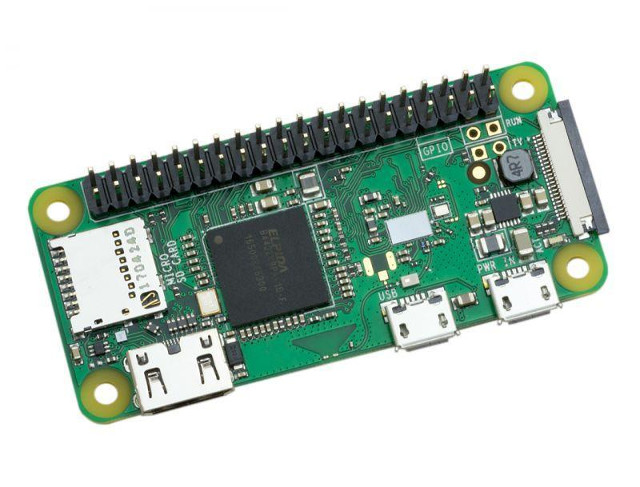Raspberry Pi Zero W was launched in February 2017 for $10 as an update to RPi Zero adding WiFi and Bluetooth connectivity. The Raspberry Pi foundation has now announced a new model called Raspberry Pi Zero WH.
What does not extra H mean? H Bridge? nope. Hybrid? nope. WH like in white PCB? re-nope. H means the 40-pin header is soldered. It can be more convenient for people who don’t own a soldering iron, or don’t feel confident soldering on their own.
 Apart from the header, Raspberry Pi Zero WH specifications remain identical to the W version:
Apart from the header, Raspberry Pi Zero WH specifications remain identical to the W version:
- SoC – Broadcom BCM2835 ARM11 processor @ 1GHz with VideoCore IV GPU
- System Memory – 512MB RAM
- Storage – microSD slot
- Video Output – mini HDMI port and composite video (via 2 unpopulated pins)
- Connectivity – 802.11 b/g/n WiFi and Bluetooth 4.0
- USB – 1x micro USB OTG port, 1x micro USB port for power only
- Camera – 1x CSI camera connector
- Expansion – Soldered 40-pin HAT-compatible header
- Power Supply – 5V via micro USB port
- Dimensions – 65mm x 30mm x 5mm
This will be convenient for pHat boards, but the foundation also mentioned GPIO expander tool to use Raspberry Pi Zero (W/WH) with a PC running Debian, or other projects where you may not want to permanently solder wires, e.g. for prototyping with a breadboard.
No price was mentioned in the blog post, and few approved resellers have stared to list the new model, but I could find it on Pimoroni, where it is sold for 11.04 GBP excluding VAT (~$15 US), and for reference the shop sells RPI Zero W for 8 GBP exc. VAT (~$11 US), so you pay around $4 to get the version with the soldered header.

Jean-Luc started CNX Software in 2010 as a part-time endeavor, before quitting his job as a software engineering manager, and starting to write daily news, and reviews full time later in 2011.
Support CNX Software! Donate via cryptocurrencies, become a Patron on Patreon, or purchase goods on Amazon or Aliexpress





just header ?….I hope RAM and Processor with quadcore 😉
“new” raspberry pi main series get update in 2019 (I hope so…)
And the usual ‘There is a maximum of 1 per customer for this product’ joke applies here too. Pimoroni does not even allow to order one Zero W and a Zero WH at the same time. So this is a $20 product since you can order only one at a time and have to add high shipping costs to every Zero. And people still are interested in these boring devices. Unbelievable.
The nuts part, is there are various GPIO kits already, to add pins yourself , GPIO Hammer Header (Solderless) on Pimoroni comes to mind.
These things 😉
https://102tube.com/video/ddLbUNlaZ3U/raspberry-pi-zero-solderless-gpio-hammer-header.html
THIS CHANGES EVERYTHING!
@crashoverride
How?
@theguyuk
I think that may explain it:
🙂
@crashoverride
Yes, it changes to TCO, as you have to include buying a soldering gun, solder wire, and know how to solder.
@zoobab
You’ve just destroyed the whole Maker movement with your financial analysis!
@willmore
Next version it will come in a kit you have to solder the SMD components yourself with a cooking plate and solder paste 🙂 That was the actual goal of the first Olimex project, to make the hardware at home. I did some SMD soldering, not a big deal to make a big part at home as long as they are not too tiny.
Orange Pi Zero isn’t an option for Pi users. GPL Violations, closed source GPU, closed source in-SoC burnt ROM bootloader vs open on FAT partition. Overheat. Some prefer ARMv6 instruction set over ARMv7. This is made in Europe without child labour. More price = better quality control.
@Jerry
Wow, drink more of the Kool-Aid.
This is a welcome addition from the perspective of someone who only wants to assemble and does not want to have to solder.
Much as i would have liked to use the Pi Zero, Zero W or in this case the Zero WH, mainly because of the camera (MIPI CSI) camera support compared to most other comparable SBCs and that for many video applications compensates the poor processing power of the Pi compared to its competitors…
…the fact remains that the Raspberry Pi offers are, as far as I see them, a scam. That’s right, a scam, there’s no other word for it. It’s really infuriating: Their artificial limit of one board per order together with the high shipping cost to pay per board order makes the REAL actual price pretty much twice the advertised price and there’s no way to get around it. You can’t do a group order with your friends either to share the shipping. That’s a textbook price scamming marketing strategy. The others don’t have such artificial restrictions that would result in an effective price doubling and have no problem to produce and deliver enough boards. So I really don’t get why Raspberry isn’t capable of doing just the same.
For me, the consequence is that I’m probably going to completely switch to H5 based boards. While I’m not quite sure about them for projects requiring a camera interface (from what I gather that’s the one point where the raspberry boards are still better), most other of their features are now well supported by the mainline kernel, as can be seen in the mainlining matrix of sunxi linux.